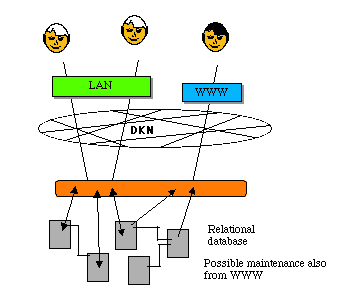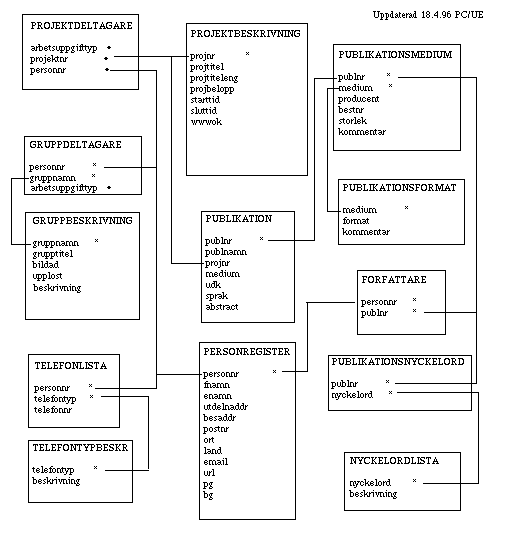
|
i6 Database
|
|
[home]
[projects]
|
Last update 1999.03.24 (1999.03.24) [1999.03.24]
|
Introduction
This is a very quickly made layout for an institute database. I have not have time to check all details in he model, but it will serve as a starting point for building a relational institute database.
Each paragraph corresponds to a table (relation) in a relational database. The 'keys' are marked with `*'.
Publications and other information is not included in the model. Also take a look at the two examples (figures) at the end.

(A) Data model
Computer:
* Id: (consecutive number)
Brand:
Model:
Prize:
Conto: (name or cont_nb then in a special conto_description)
IP number: (string or IP1,IP2,IP3,IP4)
Ethernet nb:
Mhz:
Ram (mbytes):
Disk (mbytes):
Screen Brand:
Screen Model:
Screen size:
Registration (cabinet,screen): (yes,no) (1,0)
Computer i/o installations:
* Computer id:
* Computer i/o id: (possible check if already installed)
Computer i/o:
* Id: (consecutive number)
Type: (scanner etc or special i/o type list)
Bought_year:
Brand:
Model:
Conto:
Specification: (free text)
Software:
* Id: (nb)
Name:
Version:
Brand:
Prize:
Conto:
Nb_licenses:
Conto_description:
Software installations:
* Computer id:
* Software id: (no check on number of licenses installed)
Person:
* Id: (consecutive number)
First name:
Last name:
Initials:
Position: (professor, associate_professor, …student) (or position_type)
Employment_conto_type: (either project or type with separate type_list)
Group: (either type or name) (design, analyses,....group_c201_1998_99,..)
User_name: (i6xxx)
User_name_alias:
Employed_date_year:
Employed_date_monthday:
Left_date_year:
Left_date_year_monthday:
==== when persons leave (employees or students they are kept in an Archive Person table which can be reached by UNION sql statements.
Person_room:
Room:
* Room_nb:
(Building):
room_type: (nb)
size:
Room_type:
* Room_type: (1=office, 2=group_room, 3=structrural_lab, 4=material_lab, 5=indoor_lab, ..)
Description:
Room_equipment:
* Room_nb:
* Room_equipment_type:
Number_items:
Room_equipment_type_list:
* Room_equipment_type:
Name: (kontorsstol, minihub,…)
Description:
Telephone_list:
* Person_id:
* Telephone_nb:
Telephone_type
Telephone_type_list:
* Telephone_type:
Description: 1=room installed, 2=mobile,..)
(B) Create database user access views
Views shall be defined together with end users, (1) EDB-udvalg,
(2) secretariat, (3) researcher i6, (4) teachers i6, (5) students,
- new computer (edb)
- placement of computer and IP number (edb, all)
- software installation/de-installation in computer (edb, all)
- computer i/o installation/de-installation (edb, all)
- software installation (edb)
- telephone_list (secr,all)
- employed (secr, all)
- etc.
(historical personal data can be reached through UNION statements in the SQL statement - special views for these searches)
(C) Plus and minus with a 'clean'/normalized relational database model
+ (pros)
- easy to maintain
- easy to extend
- easy to make new types of extracts
- special user views for different actions
- distributed responsibilities and maintenance
- quite easy to export to other relational databases
- (cons)
- not always overviews direct from single data register
- more initial work in making forms and i/o routines
(D) Next steps
- 'i6db' group set-up. EDB-udvalg plus additional user representatives.
- Requirements formulation including initial user view/functionality definitions according to (B).
- Meeting with i8 Electronic Systems (Wladislav). Possible use of
exisiting systems.
- Decision on requirements for i6db system.
- Decision on i6db system development project. Project cost frames.
Project participants, needed and available competences.
- It is important to define ambition level and how cost for implementing and
long term maintenance shall be distributed over time.
- Prototype runing autumn 1999.
See also
http://it.civil.auc.dk/it/education/sem6_1999/exercises/db_normalise.html
where the semester 6 exercise on relational databases shows how an Access
implementation of a student-group-project can be made.
See also
http://delphi.kstr.lth.se/reports/swebu97/swebu97.html#Heading18







